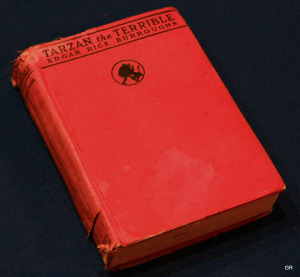Garry Rogers's Blog, page 251
June 17, 2013
Nested Stories By Secondary Characters
Stories Told by Secondary Characters
N ested stories are common literary devices. Some writing texts advocatetreating every chapter as a separate story with a beginning and an end. Nested stories can be standalone chapters, but they are usually stories narrated by characters within the framework of a chapter. A character within the main story might recall an experience, or they might tell a fictional story of their own.
ested stories are common literary devices. Some writing texts advocatetreating every chapter as a separate story with a beginning and an end. Nested stories can be standalone chapters, but they are usually stories narrated by characters within the framework of a chapter. A character within the main story might recall an experience, or they might tell a fictional story of their own.
I like nested stories; they are fine places to give readers glimpses of hidden themes and character motivations. They can add evidence for the reality of the main story. I gave an example in an earlier post about stories told by the protagonist. Here is an example of a nested story involving secondary characters in the novel Corr Syl the Warrior. The story provides support for subsequent actions within the main story.
News of Allon
As Allysen and two fighters trotted past a picnic area near the new military base, a Danog woman waved them over.
“Hello. Do you have a moment?”
Allysen focused. The woman seemed worried, and she wanted help from Tsaeb. Odd. Allysen introduced her group and asked how she could help.
______________
“I am Elaine Medlar, and this is my husband Paul. A friend of ours, Julie Snow, lived where they’re building the new army base. A Tsaeb, Allon Trofeld, stopped by while we were visiting her last month, and I wondered if you knew him.”
“I do. What happened?”
“Well, probably nothing, but we haven’t been able to reach Julie, and we’re wondering if Trofeld knew anything. Would you mind asking him to give me a call?”
“I wouldn’t mind, but I may not see him for a while. Tell me about your meeting with him.”
“Sure . . . this is a long story. Julie and I taught at Saguaro Elementary. Last January, she accepted a job in the State Education office. The new job didn’t start right away, and Julie decided to take some time off so she could work on her novel and visit her family. She moved into an old ranch house outside town. My husband Paul and I had dinner with her last month, and that’s when we met Trofeld.”
“Is the house near here?” Allysen asked.
“It was, but I think it has been torn down. It was down this road, about where the army is working on something. It was an interesting evening. The house was on a gravel road about a mile north of the city. The place was old. It had a corrugated tin roof splotched with rust, and a wrap-around porch. Inside, it felt like the ceilings were too low, and the rooms were dark. During dinner, Julie told us the Tsaeb border was a short distance farther north. After dinner, she took us out on the front porch to look at the desert. Tall Saguaro stood between round Paloverde and clusters of bristling Cholla. The air was cool, clear, and very still. It was pretty, but very quiet. After we went in, Paul said the silence was eerie. He asked Julie if she had expected it to be so quiet. She said mocking birds often sang at night, and normally you could hear owls and a cricket or two.” Elaine stopped her narrative to take a breath, and collect her thoughts.
“There was a knock and we all jumped,” she continued. “Then we laughed and Julie went to the door. When Julie opened the door we could see a tall creature with fur like yours, tawny everywhere, but white on his chest and stomach. He wore a neat brown vest and trousers, but his chest and feet were bare. He carried a walking stick and had a box under his arm. He said his name was Allon Trofeld and he had stopped by to say hello. Trofeld said he had heard the old place was rented, and had come to welcome the newcomers to the neighborhood. He held up his box, and said he had brought fruit. Julie told Trofeld she had company, and asked if he would like to come in for a moment, and Trofeld said he would be delighted to meet us.”
Elaine paused, but seeing that Allysen and the fighters were listening intently, she went on.
“Trofeld placed the box on a table beside the door and leaned his stick against the wall. Julie introduced us and he explained he was descended from mountain lions and grinned, exposing very large teeth. I remember how they gleamed in that dark little room. Trofeld’s walking stick was peculiar. A long straight cylinder about half his height, it had a shiny surface covered with fine markings. I asked Trofeld if he lived nearby. He said his home was just across the border. I asked what he did, and he said he furnished information for district council meetings, and traveled far too much. As he said this, his long whiskers twitched. I was going to ask about his walking stick, but Julie spoke up and said she was a traveler too, and had rented the house for just a few months before starting a new job.

His Round Yellow Eyes
“Trofeld asked about her job, and then asked if she had anyone living with her. Julie said no. Then Trofeld turned his large round yellow eyes on me and asked if Paul and I had any family living with us.
“I told him that our two children were at home with our babysitter. I remember adding that if we weren’t home by 10:30 and didn’t call, the babysitter would call my mother.
“I asked Trofeld if he had a family and he said they were estranged. His whiskers twitched again as he said that.
“Trofeld was remarkable. He listened with understanding to our ideas about education, politics, and the economy, he told stories and jokes, and he even taught us the difference between limericks and haiku. Let’s see, five lines; first, second, and fifth rhyme; third and fourth are shorter and form a rhyming couplet. Haiku: three lines; five, seven, and five syllables.
“When it was time for us to leave, we shook hands. Trofeld’s hand was huge, but his fingers were short. I think he had retractable claws. When he took my hand, I had a faint sensation that needles touched my wrist . . ..
“We were nearly home when I remembered my grandmother’s bowl. Paul grumbled, but turned around. I knocked, waited, and finally knocked again before the door opened. It was Trofeld, dabbing his lips with a towel.
“I told him I had forgotten my bowl.
“Trofeld volunteered to get it. He asked me what color it was. I guess he could tell I was surprised he was still there. He said Julie was fixing him a bite to eat before he went home.
“I remember feeling nervous. Julie had just met Trofeld. Doesn’t it seem odd that he answered the door?”
Allysen and the other Tsaeb did not respond.
Elaine went on. “While Trofeld was getting the bowl, I noticed his stick was gone and his box had fallen. I put the box back on the table and looked around for the stick, but didn’t see it.
“The next morning I had to start getting ready for spring semester, and I didn’t think of Julie for days. When I did, I called and left a message about having her over for dinner. She didn’t reply. I guessed she might be visiting her parents, but I tried another time, and again there was no answer. “
“And you still haven’t heard from her,” Allysen asked.
“No, we haven’t, and I’ve gotten worried. When I think about how quiet it was around her house that night, I wonder if Trofeld is still living nearby. If you see him, would you mind asking if he saw Julie again?“
“I will,” Allysen said. “Let me have your phone number. Here’s mine. Call me if you hear from Julie.”
As Allysen and the fighters went on down the road, one of the fighters muttered, “It doesn’t look good for Julie.”
Send email to Garry Rogers with this form. To make a public comment on the post, use the reply field below the form.
[contact-form]
Filed under: Techniques, Writing Tagged: nested stories, stories by secondary characters, Writing techniques









June 15, 2013
A Kirkus Star for Corr Syl the Warrior #IndieAuthor #BookMarket #kindle #SciFiChat #KidLit
Corr Syl the Warrior receives positive Kirkus review

Released: May 27, 2013
 CORR SYL THE WARRIOR
CORR SYL THE WARRIORby Garry Rogers
“A beautifully written YA novel that will captivate environmentalists and sci-fi fans of all ages.” Kirkus Reviews (starred review).
In this debut sci-fi novel, great responsibility is thrust upon a young warrior descended from rabbits who’s fighting to restore peace among humans, animals and the Earth. Read full book review >
“The Kirkus Star is awarded to books of exceptional merit” (kirkusreviews.com).
Enter the ‘Giveaway’ on Goodreads to win a copy of the book.
Email Garry Rogers or add a public comment in the reply field below the email form.
[contact-form]
Filed under: Book Review, Middle Grade, Nature Conservation, Science Fiction, YA Tagged: Kirkus Review









June 14, 2013
Indie Author Deadlines #indieauthor #litchat

Dr. Garry Rogers is Chuckling
Deadlines
By Dr. Garry Rogers
Agents and editors are generous with deadlines for freelance writers, nonfiction authors, and traditionally published novelists. Indie authors have only the deadlines they give themselves. For many of us, our self-imposed deadlines aren’t effective. We often don’t even notice the faint breeze they stir as they pass by. We need deadlines to clear away distractions and get us focused. They are the booster shots that block procrastination.
The Beauty of Deadlines
Consider the deadlines facing business entrepreneurs. There are deadlines for business formation, finance, facilities, hiring, purchasing, marketing, and shipping. Each of these requires applications and presentations, and each will have several critical deadlines. In response to all the deadlines, entrepreneurs sometimes create businesses that earn them millions or billions of dollars.
There are similarities between business entrepreneurs and indie novelists. The principal one is that both groups are creators, inventors of finely wrought complexity. So why do business entrepreneurs sometimes get rich, and authors rarely do more than earn a good living? It’s the deadlines. The heart-pounding stress of frequent deadlines gives business entrepreneurs greater opportunity for success.
Deadline Magic
Looming deadlines cause wonderful physiological responses. Scientists have learned that external stress causes your body to begin manufacturing and releasing epinephrine, cortisol, and other hormones. Your energy level rises, your memory functions improve, your disease immunity increases, and your pain threshold rises. There may be corresponding physical and mental discomforts; you may loose sleep, you may become nauseated, and you may loose your appetite. You can moderate the discomfort with exercise, yoga, meditation, etc. The best moderator, however, is meeting the deadline! Besides all the other benefits of completing a goal, there is lovely relief when you meet a deadline.
Where Are the Deadlines?
How can you get deadlines? For independent authors it’s tough. Contests and grants have deadlines, critique groups have deadlines, and challenges such as the national novel writing month have deadlines. And of course, you can set goals and deadlines for yourself. Unfortunately, you can find ways to excuse yourself from any of these deadlines.
Giving Your Deadlines Teeth
You have to give power to your self-imposed deadlines—awesome power beyond your control. You can do this with social pressure. Extreme social pressure is hard to ignore. To give a deadline the power to make you puke, pick meaningful, not just memorable dates—instead of a phase of the moon or a national holidays, choose your wedding anniversary, your mother’s birthday, your girl friend’s birthday, or your first-born child’s birthday.
Next, and this is the really critical part, tell everyone your goals and your deadlines. Tell your family, friends, fiancé, neighbors, writing groups, coffee shop servers, Facebook followers, high school graduating class, and others. Especially don’t forget your enemies. You want to be sure that there are people are looking forward to sharing your success, and people who will delight in your failure.
Danger of Powerful Deadlines
Good strong deadlines will have you refusing afternoon softball games, camping trips, children’s football tournaments, and even dinner dates. If you forget to exercise and eat properly, your health may suffer. But with experience, you can learn to create powerful deadlines that increase your chance for success, fame, and fortune. Millions? Maybe. Billions? Don’t forget your doctor.
Filed under: Uncategorized Tagged: Deadlines, Indie Authors, Writing techniques









June 13, 2013
The True Beauty of Book Covers
Book Covers: Behind the Beauty
 I only recently began to question the old line, “you can’t judge a book by its cover.” Having never really given the subject any thought, I always assumed that the sole purpose of a book cover was to attract buyers. I thought of it as an advertising gimmick that served a commercial purpose and had nothing to do with the quality of the story. I felt that plain covers might be more honest and desirable.
I only recently began to question the old line, “you can’t judge a book by its cover.” Having never really given the subject any thought, I always assumed that the sole purpose of a book cover was to attract buyers. I thought of it as an advertising gimmick that served a commercial purpose and had nothing to do with the quality of the story. I felt that plain covers might be more honest and desirable.
When I completed my first novel, “Corr Syl the Warrior,” my attitude changed. I was concerned that since I had no reputation at all, there might be no readers. I was confident that some readers would like the story, but I was feared that those readers might never stumble upon the book. I decided that I needed a snazzy cover.
The only thing I knew about eBook cover design was that the fonts had to be legible at thumbnail sizes. Other than that, I assumed a book-cover designer would create something attractive that would appeal to potential buyers. I checked a few websites for examples, and chose a designer that had made some science fiction covers. I provided a one-paragraph book description and a few pictures, and sat back to see what she would produce.
The designer did a great job with what I gave her. She proposed a few options, suggested colors and fonts, and ended up doing a beautiful job. Along the way, I thought more about book covers and realized that I had missed an opportunity. I began looking closely at the covers on the books on my shelves and I realized that book covers could play a significant role in telling a story.
With shapes, colors, and text, a cover could set a mood and it could illustrate important story elements. An author could use the cover to foreshadow important events within the story. I realized that the cover could also help define characters, give a real glimpse of a setting, and give clues to the story theme.
The first book I read to myself, “Tarzan the Terrible,” has gone through numerous printings since its publication in 1921. And it has had at least 20 different covers. The covers range from simple text to images that seem unrelated to the story, and to images that illustrate important scenes and the story theme.

Tarzan the Terrible
As a child, I often wondered what the image on the cover was. I imagined several possibilities, and finally settled on one. I think it depicts a particular scene in the story. I could be wrong. If you think you know what the image is, add a comment.
Book covers can be more than mere advertising, or even works of art. They can be beautiful, informative, and suggestive all at once. A cover designer might achieve all that, but a designer working together with the book’s author is more likely to take full advantage of the opportunity the cover provides. If the author can describe what the cover could show, a good designer can probably put it together.
So, can you tell a book by its cover? YES, if the author takes the time to help with its composition.
Send an email to Garry Rogers or make a public comment using the reply field below the email form.
[contact-form]
Filed under: Book Promotions, Techniques, Writing Tagged: Book covers, Book Marketing, Writing techniques









June 10, 2013
Nested Stories told by the Protagonist #indieauthor #LitChat
Nested Stories told by the Protagonist
The protagonist in a novel often imagines or recalls events that are not part of the main story. Nesting small stories within a story is a common literary device sometimes referred to as mise en abyme. An article in Wikipedia discusses the many types of nested stories. Here I am referring to stories narrated by a protagonist and nested well with a main story.
Nesting self-contained stories within a larger narrative is probably as old a technique as story telling itself. The storyteller often draws the story from a remembered experience, but sometimes tells a fictional story heard or invented. A nested story may make up the bulk of a chapter; it can even stand alone, seemingly unrelated to the main story. Steinbeck uses the latter in his depiction of the two boys in Chapter 26 in Cannery Row.
Some books are composed entirely of stand-alone stories framed by a unifying plot. Canterbury Tales and One Thousand and One Nights are examples. Collections of children’s stories such as Winnie the Pooh are similar, but repeating characters, not the plot unite them. One of my projects is a collection of children’s stories united by a single character whose excesses of ego and poor judgment, creates circumstances that form the plot for each story.
Nested stories serve many purposes. Steinbeck used them to give insights to his theme. The stories can also show character motivations and they can reveal details of history and background for the main story. Thus, they can support the reality of the main story.
Here is an example of a nested story told by the protagonist in the novel Corr Syl the Warrior. It is contained within a chapter, and it is obvious fiction. It serves to elaborate on the background of the protagonist’s culture and his occupation, and it foreshadows a tragic scene involving the protagonist and a childhood friend.
______________
Nested Stories Example
Corr lifted his weapons harness from its peg on the wall and began appraising his current story stream. With friends, Corr listened for the right moment to tell a story. One stream of thought usually worked on a new story or revised an old one. He filed stories away and waited for a chance to try them on friends. His considered how he would segue into his latest story the next time he saw Rhya.

The Big-eared Rabbit with a Large Tail
The story idea came from a picture. Once, Corr’s mother took a framed picture down from the wall and stood it before the two-year old rabbit. The frame held a rubbing made from an etching of a long-eared rabbit with a great bushy tail. As Corr looked, he raised his hands and felt his much smaller ears.
“This warrior rabbit lived long ago,” said Corr’s mother. “The large ears probably helped him hear and keep cool. No one knows for sure why he had such a large tail.”
A geologist had found the etching sandwiched between layers of sedimentary rock. Corr’s parents gave him the picture when he completed warrior training.
In Corr’s new story, a warrior struggled to kill Ankalagon, a deadly predator whose fossils occurred in the same layers of sedimentary rocks as the etching.
Paleontologists often found a sharp gouge on the dens, a small bony projection in Ankalagon’s neck. The dens extended from the rim of the second cervical vertebra up into the ring of the atlas, the first vertebra at the base of Ankalagon’s skull. The dens served as an anchor for ligaments that held the skull in place and kept it from twisting too far. A heavy bony extension of the atlas protected the dens and the precious spinal cord beneath.
The picture had given Corr the idea for the story’s theme: Behavior could outlive shape. Corr decided to make the main character female like Rhya; the District’s only other rabbit warrior.
PERSISTENCE
By Corr Syl
A beautiful [too obvious] young battle rabbit, long ears clamped against her slender neck, gorgeous magnificent warrior’s tail tight against her body, lay hidden among the small branches and leaves of a tree limb over a trail. The rabbit intended to drop onto the back of the predator Ankalagon and kill it with her sword. Ankalagon had recently invaded the region and had begun preying on the rabbit’s friends and family. More of the predators kept coming. Powerful and smart, the beast had avoided every trap, and had beaten every attack. Rabbits and other species began to consider emigration.
The brilliant rabbit had studied Ankalagon for months. She knew when and where the beast slept, drank, and hunted. She knew how it ran, walked, and rested. She knew how it killed and how it defended itself. She had even found and studied a skeleton. But nothing suggested a new offensive tactic. One morning while thinking about going to help plan the emigration, the rabbit watched Ankalagon stretch its head down to drink from the river; the beast’s posture gave her an idea. The rabbit ran to the thicket where the skeleton lay and began arranging the bones.
The next morning the rabbit waited beside the path that one of the predators often used to go down to a spring at the edge of the dry river. She checked her weapons and took deep breaths of the cool air filled with sweet scents of budding flowers. At last the beast came trotting down the trail. The rabbit stepped out, yelped, and ran. Ankalagon snorted and pursued. Racing ahead, the rabbit sprang into an old willow beside the river, threw herself out on a branch over the trail, and held her breath.
Lying there, the tiny warrior had a bloody vision of the huge beast biting her in half. Her mind filled with uncertainty. Ankalagon passed beneath. She couldn’t move. Almost too late, the rabbit pushed herself up and leapt onto the creature’s back. Ankalagon stopped. The rabbit scrambled forward, grabbed an oily fold of skin at the base of the neck, and let her free arm and her tail whip about to absorb the momentum of the beast’s violent shake.
The shaking stopped abruptly and the rabbit snapped her tail back, leapt forward, and clamped her legs around Ankalagon’s neck. The irritated beast shook again, arched its head down, and reached up to claw the rabbit off. As the beast’s neck reached its greatest downward arch, the rabbit drove her short sword through the narrow gap that opened between the first and second cervical vertebrae. The plunging sword’s point snapped off the dens, and sliced downward into Ankalagon’s spinal cord.
The rabbit jumped clear as Ankalagon roared and staggered to its knees. Gaining her feet, the rabbit lunged in and drove her long sword between two upper ribs, piercing the beast’s heart.
The warrior taught others the technique and led a campaign to eradicate Ankalagon. She became famous, inspiring art and legend. Her technique entered warrior lore and persisted long after ears became small and tails disappeared.
~
Corr smiled, thinking: Maybe Rhya likes historical fiction. She probably knows about Ankalagon, the dens mystery, and the technique. Corr’s teacher said no one knew who invented the technique, so why couldn’t it have been the long-eared rabbit with the great bushy tail?
Use this form to send email to Garry Rogers. Use the reply field below the email form to make a public comment on this post.
[contact-form]
Filed under: Techniques, Writing Tagged: nested stories, stories by the protagonist, Writing techniques









Writing Techniques: Stories told by the Protagonist
Nested Stories told by the Protagonist
The protagonist in a novel often imagines or recalls events that are not part of the main story. Nesting small stories within a story is a common literary device sometimes referred to as mise en abyme. An article in Wikipedia discusses the many types of nested stories. Here I am referring to stories narrated by a protagonist and nested well with a main story.
Nesting self-contained stories within a larger narrative is probably as old a technique as story telling itself. The storyteller often draws the story from a remembered experience, but sometimes tells a fictional story heard or invented. A nested story may make up the bulk of a chapter; it can even stand alone, seemingly unrelated to the main story. Steinbeck uses the latter in his depiction of the two boys in Chapter 26 in Cannery Row.
Some books are composed entirely of stand-alone stories framed by a unifying plot. Canterbury Tales and One Thousand and One Nights are examples. Collections of children’s stories such as Winnie the Pooh are similar, but repeating characters, not the plot unite them. One of my projects is a collection of children’s stories united by a single character whose excesses of ego and poor judgment, creates circumstances that form the plot for each story.
Nested stories serve many purposes. Steinbeck used them to give insights to his theme. The stories can also show character motivations and they can reveal details of history and background for the main story. Thus, they can support the reality of the main story.
Here is an example of a nested story told by the protagonist in the novel Corr Syl the Warrior. It is contained within a chapter, and it is obvious fiction. It serves to elaborate on the background of the protagonist’s culture and his occupation, and it foreshadows a tragic scene involving the protagonist and a childhood friend.
______________
Corr lifted his weapons harness from its peg on the wall and began appraising his current story stream. With friends, Corr listened for the right moment to tell a story. One stream of thought usually worked on a new story or revised an old one. He filed stories away and waited for a chance to try them on friends. His considered how he would segue into his latest story the next time he saw Rhya.

The Big-eared Rabbit with a Large Tail
The story idea came from a picture. Once, Corr’s mother took a framed picture down from the wall and stood it before the two-year old rabbit. The frame held a rubbing made from an etching of a long-eared rabbit with a great bushy tail. As Corr looked, he raised his hands and felt his much smaller ears.
“This warrior rabbit lived long ago,” said Corr’s mother. “The large ears probably helped him hear and keep cool. No one knows for sure why he had such a large tail.”
A geologist had found the etching sandwiched between layers of sedimentary rock. Corr’s parents gave him the picture when he completed warrior training.
In Corr’s new story, a warrior struggled to kill Ankalagon, a deadly predator whose fossils occurred in the same layers of sedimentary rocks as the etching.
Paleontologists often found a sharp gouge on the dens, a small bony projection in Ankalagon’s neck. The dens extended from the rim of the second cervical vertebra up into the ring of the atlas, the first vertebra at the base of Ankalagon’s skull. The dens served as an anchor for ligaments that held the skull in place and kept it from twisting too far. A heavy bony extension of the atlas protected the dens and the precious spinal cord beneath.
The picture had given Corr the idea for the story’s theme: Behavior could outlive shape. Corr decided to make the main character female like Rhya; the District’s only other rabbit warrior.
PERSISTENCE
By Corr Syl
A beautiful [too obvious] young battle rabbit, long ears clamped against her slender neck, gorgeous magnificent warrior’s tail tight against her body, lay hidden among the small branches and leaves of a tree limb over a trail. The rabbit intended to drop onto the back of the predator Ankalagon and kill it with her sword. Ankalagon had recently invaded the region and had begun preying on the rabbit’s friends and family. More of the predators kept coming. Powerful and smart, the beast had avoided every trap, and had beaten every attack. Rabbits and other species began to consider emigration.
The brilliant rabbit had studied Ankalagon for months. She knew when and where the beast slept, drank, and hunted. She knew how it ran, walked, and rested. She knew how it killed and how it defended itself. She had even found and studied a skeleton. But nothing suggested a new offensive tactic. One morning while thinking about going to help plan the emigration, the rabbit watched Ankalagon stretch its head down to drink from the river; the beast’s posture gave her an idea. The rabbit ran to the thicket where the skeleton lay and began arranging the bones.
The next morning the rabbit waited beside the path that one of the predators often used to go down to a spring at the edge of the dry river. She checked her weapons and took deep breaths of the cool air filled with sweet scents of budding flowers. At last the beast came trotting down the trail. The rabbit stepped out, yelped, and ran. Ankalagon snorted and pursued. Racing ahead, the rabbit sprang into an old willow beside the river, threw herself out on a branch over the trail, and held her breath.
Lying there, the tiny warrior had a bloody vision of the huge beast biting her in half. Her mind filled with uncertainty. Ankalagon passed beneath. She couldn’t move. Almost too late, the rabbit pushed herself up and leapt onto the creature’s back. Ankalagon stopped. The rabbit scrambled forward, grabbed an oily fold of skin at the base of the neck, and let her free arm and her tail whip about to absorb the momentum of the beast’s violent shake.
The shaking stopped abruptly and the rabbit snapped her tail back, leapt forward, and clamped her legs around Ankalagon’s neck. The irritated beast shook again, arched its head down, and reached up to claw the rabbit off. As the beast’s neck reached its greatest downward arch, the rabbit drove her short sword through the narrow gap that opened between the first and second cervical vertebrae. The plunging sword’s point snapped off the dens, and sliced downward into Ankalagon’s spinal cord.
The rabbit jumped clear as Ankalagon roared and staggered to its knees. Gaining her feet, the rabbit lunged in and drove her long sword between two upper ribs, piercing the beast’s heart.
The warrior taught others the technique and led a campaign to eradicate Ankalagon. She became famous, inspiring art and legend. Her technique entered warrior lore and persisted long after ears became small and tails disappeared.
~
Corr smiled, thinking: Maybe Rhya likes historical fiction. She probably knows about Ankalagon, the dens mystery, and the technique. Corr’s teacher said no one knew who invented the technique, so why couldn’t it have been the long-eared rabbit with the great bushy tail?
Use this form to send email to Garry Rogers. Use the reply field below the email form to make a public comment on this post.
[contact-form]
Filed under: Techniques, Writing Tagged: nested stories, stories by the protagonist, Writing techniques









June 5, 2013
Books I have written
June 2, 2013
Divest to Save Butterflies, Humans, and Turtles #biodiversity #turtles #poverty
A few dozen companies cause most of the world’s social and environmental problems. They lobby and bribe our elected officials, they influence our regulatory agencies, and they profit from our labor and the exploitation of Earth’s resources.

Energy Production Pollution by Owen Byrne
_________________
Here are the major industries (CEFIM–chemical, energy, finance, insurance, military) with harmful companies. Each CEFIM industry is dominated by a few companies.
Chemical (drugs and pesticides)
Energy (coal, petroleum, atomic),
Finance (banks and credit card companies),
Insurance (health, liability, life)
Military (aircraft, weapons, ammunition, explosives).
So who are the CEFIM companies?
The Pesticide Action Network provided an infographic concerned with pesticides, seeds, and other biotechnology. It shows how a few chemical companies dominate the global market.

All the companies are corporations whose directors and officers are highly influenced by quarterly and annual revenue/profit reports. That is understandable, because there can be no companies without profits. But when the actions of the companies produce undesirable consequences (declining biodiversity and human disease, debt, and deadly conflicts), their continuation is no longer desirable.
Divestment can influence large companies. The divestment in companies doing business in South Africa was a key force in breaking down the apartheid system. We should withdraw investments from companies whose actions harm the Earth and its inhabitants.
Can you name some of the companies in the categories above (CEFIM ) that deserve divestment?
[contact-form]



May 31, 2013
My Debut Novel, Corr Syl the Warrior is available on Amazon
Description
When an armed Danog patrol crosses the border into Wycliff District, the Wycliff Council sends a young Tsaeb warrior named Corr Syl to investigate and recommend a response. Corr soon learns that spies have infiltrated his district, and already many lives are at risk. He catches a glimpse of something truly evil, and with no time to spare, must choose

Corr Syl the Warrior Cover
between a safe response that might fail, and a sure response that might start a global war.
The Tsaeb civilization formed millions of years ago. Its creators were the warriors who appeared in the time of massive war machines that had the power to destroy the planet itself. In addition to strength and knowledge of combat and war, the warriors brought a wisdom that centered on individual responsibility for consequences of actions. This form of wisdom is Immediacy, the philosophy of consequences. The spread of Immediacy produced the Tsaeb civilization. During its 40-million year history, the Tsaeb civilization survived giant meteorites and advancing ice sheets, but always the greatest danger is from new species.
This novel is free of profanity and erotica, but it does contain violence. It has action, adventure, heroics, romance, true evil, and a bad joke or two: Everything you need?
Contact me:
[contact-form]



Corr Syl the Warrior FREE Today, #Must Read, #StoryFriday, #FreeBook
The Kindle edition of my debut (prolegomenon) novel is FREE today only on Amazon.

Corr Syl the Warrior Cover
When an armed Danog patrol crosses the border into Wycliff District, the Wycliff Council sends a young Tsaeb warrior named Corr Syl to investigate and recommend a response. Corr soon learns that spies have infiltrated his district, and already many lives are at risk. He catches a glimpse of something truly evil, and with no time to spare, must choose between a safe response that might fail, and a sure response that might start a global war.
The Tsaeb civilization formed millions of years ago. Its creators were the warriors who appeared in the time of massive war machines that had the power to destroy the planet itself. In addition to strength and knowledge of combat and war, the warriors brought a wisdom that centered on individual responsibility for consequences of actions. This form of wisdom is Immediacy, the philosophy of consequences. The spread of Immediacy produced the Tsaeb civilization. During its 40-million year history, the Tsaeb civilization survived giant meteorites and advancing ice sheets, but always the greatest danger is from new species.
This novel is free of profanity and erotica, but it does contain violence. It has action, adventure, heroics, romance, true evil, and a bad joke or two: Everything you need?
Contact me:
[contact-form]







